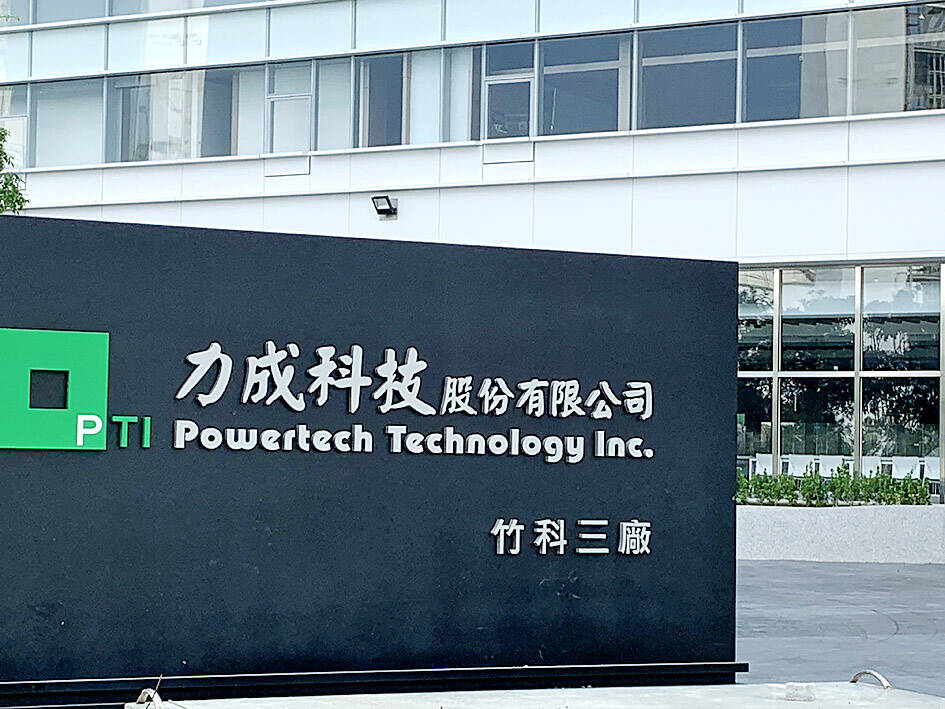Chip testing and packaging service provider Powertech Technology Inc (PTI, 力成科技) plans to increase this year’s capital expenditure by 50 percent to expand capacity to meet growing demand for advanced memorychips used in artificial intelligence (AI) products.
The company proposed to spend NT$15 billion (US$460.94 million) to expand advanced capacity and equipment, compared with a budget of NT$10 billion it planned three months ago.
“We are seeing a recovery in market demand as well as new business opportunities. We will spend heavily on advanced packaging” equipment, Powertech chief executive officer Boris Hsieh (謝永達) told investors on Tuesday. “We will focus on ramping up advanced technologies we have developed in the past few years. We believe PTI will begin to harvest its investments in advanced technologies this year.”

Photo: Grace Hung, Taipei Times
A major portion of the capital budget would be spent on advanced, or 2.5D, packaging technologies used in AI and high-performance computing (HPC) chips, including through-silicon vias technology for high-bandwidth memorychips and advanced testing technology, the company said.
The investment would also be used to boost advanced flip chip ball grid array technology packaging capacity for higher-density and faster advanced DRAM DDR5 chips, which are used in edge AI devices such as smartphones and computers with AI capabilities, it said.
The Hsinchu-based memorychip packager expects a gradual increase in revenue contribution from advanced packaging and testing technologies for high-bandwidth memorychips from the final quarter of this year, given equipment supply constraints.
In the near term, PTI expects revenue this quarter to grow a mid-to-high single-digit percentage this quarter from NT$18.33 billion last quarter, thanks to a pickup in chips used in consumer application chips from the current quarter, Hsieh said.
“As demand for PCs, smartphones and consumer products gradually increases in the second quarter, revenue will grow compared with the first quarter,” Hsieh said. “Besides, data center and HPC application demand is driving an increase in DDR5 DRAM.”
NAND flash memorychip packaging and testing revenue is expected to grow by a double-digit percentage sequentially this quarter due to rising demand for solid-state drive storage for data centers, he said.
“We are optimistic that AI-related applications will gradually emerge in the second half,” he said.
The company expects chip packaging equipment utilization to rise to about 75 percent this quarter from 70 percent, while testing equipment use is to increase to 55 percent from 50 percent.
DRAM packaging and testing services accounted for 24 percent of the company’s total revenue last quarter, while NAND flash memorychips made up 28 percent. Logic packaging and testing services accounted for 37 percent.
PTI on Tuesday reported annual growth of 54 percent in net profit for last quarter, totaling NT$1.74 billion, compared with NT$1.13 billion in the first quarter of last year.
On a quarterly basis, it declined 56 percent from NT$3.97 billion, including an asset disposal gain of NT$2.6 billion.
Earnings per share rose to NT$2.32 last quarter from NT$1.51 in the same period last year, but plummeted NT$5.31 in the previous quarter.

GROWING OWINGS: While Luxembourg and China swapped the top three spots, the US continued to be the largest exposure for Taiwan for the 41st consecutive quarter The US remained the largest debtor nation to Taiwan’s banking sector for the 41st consecutive quarter at the end of September, after local banks’ exposure to the US market rose more than 2 percent from three months earlier, the central bank said. Exposure to the US increased to US$198.896 billion, up US$4.026 billion, or 2.07 percent, from US$194.87 billion in the previous quarter, data released by the central bank showed on Friday. Of the increase, about US$1.4 billion came from banks’ investments in securitized products and interbank loans in the US, while another US$2.6 billion stemmed from trust assets, including mutual funds,

AI TALENT: No financial details were released about the deal, in which top Groq executives, including its CEO, would join Nvidia to help advance the technology Nvidia Corp has agreed to a licensing deal with artificial intelligence (AI) start-up Groq, furthering its investments in companies connected to the AI boom and gaining the right to add a new type of technology to its products. The world’s largest publicly traded company has paid for the right to use Groq’s technology and is to integrate its chip design into future products. Some of the start-up’s executives are leaving to join Nvidia to help with that effort, the companies said. Groq would continue as an independent company with a new chief executive, it said on Wednesday in a post on its Web

JOINT EFFORTS: MediaTek would partner with Denso to develop custom chips to support the car-part specialist company’s driver-assist systems in an expanding market MediaTek Inc (聯發科), the world’s largest mobile phone chip designer, yesterday said it is working closely with Japan’s Denso Corp to build a custom automotive system-on-chip (SoC) solution tailored for advanced driver-assistance systems and cockpit systems, adding another customer to its new application-specific IC (ASIC) business. This effort merges Denso’s automotive-grade safety expertise and deep vehicle integration with MediaTek’s technologies cultivated through the development of Media- Tek’s Dimensity AX, leveraging efficient, high-performance SoCs and artificial intelligence (AI) capabilities to offer a scalable, production-ready platform for next-generation driver assistance, the company said in a statement yesterday. “Through this collaboration, we are bringing two

Even as the US is embarked on a bitter rivalry with China over the deployment of artificial intelligence (AI), Chinese technology is quietly making inroads into the US market. Despite considerable geopolitical tensions, Chinese open-source AI models are winning over a growing number of programmers and companies in the US. These are different from the closed generative AI models that have become household names — ChatGPT-maker OpenAI or Google’s Gemini — whose inner workings are fiercely protected. In contrast, “open” models offered by many Chinese rivals, from Alibaba (阿里巴巴) to DeepSeek (深度求索), allow programmers to customize parts of the software to suit their